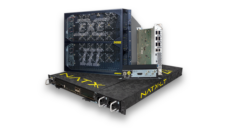SIGNAL TRAFFIC
Jul 1, 1998 12:00 PM,
Michael Balch
The concept of a matrix switcher seems simple. Take the output signals of aspecific number of audio, video or other source devices and switch themthrough to some number of monitoring, display or recording destinations sothat any of the destinations can use any one of the source signals at anygiven time. After a closer look, however, there is more to a matrixswitcher than first meets the eye. With applications in everything fromhigh-end home theater and security systems to large presentation systemsand command/control centers, the matrix switcher acts as the centerpiece ofmodern A-V systems. In fact, more and more A-V system designers find thatit pays off, in both the short and long run, to take a close look at thisdevice and the technical issues associated with it. We’ll start byestablishing a simple application and use it to analyze available switcherarchitectures and other matrix switcher issues like control, bandwidth andconnections.
Real-world applicationsIn this decade of multimedia, the needs of modern A-V applications havebecome increasingly demanding. With the trend of A-V systems becominglarger and more complex, along with the need to use a mixture of consumer-and professional-grade components in such systems, a manual patching systemor patch panel cannot always meet the needs of today’s end-users. As anexample, consider the simple corporate boardroom A-V applicationillustrated in Figure 1.
With a moderate amount of A-V experience and a quick perusal of thecomponents in this system, it is easy to imagine the possible scenarios inwhich the users of the system will be operating it. Taking the perspectiveof the end-user, which will ultimately judge the success of the systemdesign and installation, the overall system must be flexible, easy to useand dependable. What’s most likely transparent to the end-user are theperils of designing a system to interconnect an array of devices that mayhave various connector standards, source and load impedances, and signalamplitude and frequency characteristics. An account executive from thecompany’s advertising agency will need to walk in with a laptop, connect iton the conference table, and with it perform a computer-generated slidepresentation on the projector screen simultaneous with background audiofrom a CD player mounted in the rack. The requirements of the user will bethe rapid execution of these tasks with the confidence of a quality endresult. The challenge to the contractor is to create a system that willallow the end user a simple, user-friendly method of configuring thescenarios that fit current needs, while at the same time integrating theflexibility to meet future requirements.
Fixed vs. modular systemsA-V matrix switchers are generally available in two distinctarchitectures-fixed and modular I/O configurations. The fixed variety istypically available in smaller I/O sizes (16 x 16 and smaller) and isgenerally the least expensive because it can be designed so that its signalpaths remain on a single circuit board. (See Figure 2.) Thus, manufacturingcosts less, and performance design goals are easier to reach.
The second architecture separates the input and output sections into modules, typically of four or eight inputs or outputs, and signals travel througha third center section or backplane board, which serves as a conduit frominput to output modules. This architecture is designed for easy expansionof inputs and outputs separately and for quick system reconfiguration.Actual signal switching can take place on either the backplane or outputboards or both. The trade-off with modular systems is that they aregenerally more expensive than fixed configurations. The largest portion ofmatrix system cost is a combined function of performance (the ability topass the signals unscathed), number of cross-points (inputs times outputs)and expansion capability (the ability to add more source or destinationdevices or to add new emerging signal types). Having a switching systemmeet future needs adds a premium, but it will most likely prove to be agood investment. (See Figure 3).
There is also a third alternative, which is a hybrid of the previous twotechnologies where each modular I/O circuit board is a matrix within itselfand can be combined with other similar boards to realize multiple componentsignals on multiple levels. I/O boards plug into a backplane in this typeof architecture also, but only for use of power and control signals. Routedsignals remain on a single board, so the cost advantages of a fixed matrixsystem are for the most part retained. This alternative does not allowexpansion of inputs or outputs separately by simply adding modules, butrequires upgrading the current I/O boards to a larger size if I/O expansionis needed. (See Figure 4.) This type of architecture is more economicalthan a full modular system and is ideal for applications that do notnecessarily need simple I/O expansion but do need the capability to add newor alternate signal types in the future.
Now let’s look at the requirements of our simple boardroom example withrespect to different switching system architectures. In Table 1, each ofthe I/O devices are listed in groups of source or destination signal typesbased on likely scenarios. This example shows that determining the bestproduct for a specific application’s needs requires more than counting thenumber of input and output devices; you really need a fairly completevisualization of how the end product will function. Notice the separationof audio into two groups-one for stereo audio (routing stereo sources tothe analog processor) and the second for six-channel audio for routing fromthe two processors to the three amps. This will allow use of a single setof amps and loudspeakers with separate analog and digital surroundprocessors in an automated fashion based on which audio source is in use.
Listing the devices in this manner renders it easy to see that theswitching system will need at least five high-resolution RGBHV inputs withat least four outputs, six composite video inputs with at least fivecomposite video outputs, ten stereo audio inputs with two stereo audiooutputs, and two six-channel audio inputs with three six-channel audiooutputs. Examining the option of a fixed matrix system, a combination offour products would work-a fixed 8 x 4 RGBHV matrix switcher, a fixed 8 x 8composite video matrix switcher, a fixed 12 x 4 stereo audio matrixswitcher, and two fixed 8 x 12 stereo audio switchers for the six-channelaudio (assuming that a 2 x 3 six-channel audio matrix is not offered in themarket). Each box would require a dedicated data line from the controlinterface, and extra logic in the control system to handle the six-channelaudio routing would be necessary.
In this case, a modular solution will allow us to combine a 8 x 4 RGBHVmatrix switcher, an 8 x 8 composite, a 12 x 2 stereo audio and a 2 x 3six-channel audio switcher all in one system. The modular solution willalso make control straightforward. In determining the best brand, look fora modular system that is software configurable, which will allow control ofeach six-channel audio source as if it were a single channel instead ofissuing six switch commands every time we want to initiate a change. Thesoftware-configurable system will also allow group switching any audiosource in combination with any of the video sources as needed.
Uninhibited controlWith so many different applications for matrix switchers, there are variedrequirements for controlling them and other integrated products. Again,visualizing all possible scenarios of the system’s usage will help definethe type of control system and interface. Budget issues also play a role.With regard to the matrix switcher, control it either alone or inconjunction with a number of other devices in the installation. In thefirst case, all matrix switcher manufacturers have several options forlocal and/or remote control of the switcher, and most provide free orinexpensive point-and-click control software products.
In the case of needing to control an array of products that include thematrix switcher, several control system manufacturers produce programmablecontrol systems with easy-to-use integrated interfaces like push-buttonwall panels and LCD touch panels. To be controlled by one of these systems,a serial control interface (RS-232/RS-422) is either standard or an optionon most matrix switchers. In either case, it is usually a good idea toorder a matrix system with a local control panel so that another form ofcontrol is available in case of control system failure.
In the boardroom example, it is necessary to control many devices in asemi-automated manner. In fact, one push of a control-panel button couldinitiate ten to 20 changes in the complete system. One possible controlscenario might be, through a touch panel mounted on the presentation table,the user can push a button called “Laptop 4 Presentation,” which will causethe control system to transmit the commands to:
* Switch RGBHV video from the Laptop Input #4 to the projector.
* Switch the corresponding stereo input for Laptop Input #4 to the analogaudio pre-amplifier/processor.
* Switch three audio channels from the pre-amplifier (right, left,subwoofer) out to five amplifier channels (right front, left front, rightrear, left rear, subwoofer) for a non-surround source.
* Turn the video projector on and switch it to the RGBHV input.
* Dim the lights and close the blinds.
Similar processes can be programmed for automated execution of many otherscenarios. When specifying a matrix switcher, be sure that it supports asimple ASCII-based serial command protocol to minimize the complexity ofprogramming external control devices.
Bandwidth is importantIn the matrix switcher market, much attention is devoted to bandwidth.Although cabling and switcher performance is less of an issue with standardcomposite video signal transfer, it is extremely important inhigh-resolution computer video or digital signal paths. Becausehigh-resolution signals can push the performance limits of routing andcabling components, the combined performance effects of the cabling and theswitching electronics must be considered. Increased bandwidth performancemeans higher cost; therefore, careful analysis of the bandwidth performanceneeds of an installation can save in system cost and may mean thedifference between winning and losing a bid.
Bandwidth for a signal path component is the range of frequencies that canpass through to the output of the component while retaining at least halfthe power of the original signal, or more accurately, while retaining arelative amplitude within the range of +/-3 dB to the input over that fullrange of frequencies. Whenever a signal passes through multiple components,the losses are cumulative. For example, when a signal passes through twocomponents that are rated at 300 MHz, the resulting effect on the signal isa -6 dB attenuation of the signal at 300 MHz. Different path componentsaffect signals differently, and depending upon the spectral density of thesignal being transferred, these effects may or may not be significant inthe critical information-bearing frequencies of the signal.
If signal path components (switchers, interfaces and cabling) are specifiedwith bandwidth ratings that are high enough in relation to the frequencyrange of the signal being passed, then no other analysis is necessary. Forthis reason, designers sometimes use a rule-of-thumb approach to estimatebandwidth requirements. The rule-of-thumb approach starts out with acalculation based on the screen resolution of the actual computer videosource(s) to be routed, then the result is multiplied by a fudge factor,usually three, which is included to compensate in the worst possible casefor compound effects of multiple signal degrading components in the path.This can be likened to using a firehose to feed into a garden hose. Whileguaranteed that you are minimizing back pressure, a hose half the sizewould be just as effective. The rule-of-thumb approach works, but it is nota recommended method because the resulting specification is a system thatusually outperforms the needs of the user.
A superior method is to consider the number and type of components in thesignal path (including cabling) and the significant contribution each willmake, if any, to the degradation of the signal. For example, Figure 5represents a single-channel signal flow through the example application.The computer source resolution is 1,024 x 768 pixels at 90 Hz verticalrefresh. There is 30 feet (9 m) of cable on both sides whose ratedbandwidth is 200 MHz to 30 feet (9m), and our projector has a maximum RGBbandwidth of 120 MHz. To calculate source resolution, take the total amountof pixels (1,024 x 768 = 786,432) and multiply by the vertical refreshrate, which yields the resolution of the computer video signal (786,432 x90 = 71 MHz). This means that ideally, the combined frequency response ofall signal path components between the computer and the projector should beflat (+/-1dB) from DC to 71 MHz. Using the rule-of-thumb method, this valueis multiplied by a fudge factor of three, and the switcher bandwidthestimate is 213 MHz, which would require specification of a 250+ MHz matrixswitcher and would also suggest that the cabling is insufficient.
Additionally, examine how the other components in the path affect thesignal over the critical frequencies. The system cost can be reduced byinstalling a matrix with only 100 MHz bandwidth performance, and our 200MHz rated cable is more than sufficient. Of course, all system devicesshould be analyzed similarly, but a quick assessment of the specificationsof the signal path components will always provide the most cost-effectivesolution.
Connections and terminationsWhen designing an A-V system that will use a matrix switcher, it isimportant to understand the available connector types and lineterminations. A good matrix switcher will be designed to allow concurrentusage of devices with somewhat different transmission and loadrequirements. For example, with line-level audio, devices are typically oneof two grades with regard to connection standards-professional andconsumer. The professional standard is designed for use where audio signalsare driven over longer distances and must be capable of rejecting highlevels of induced noise. This standard is a balanced line (three-wire,+/ground/-), which uses either a three-position screw terminal connectionor an XLR-type connector. The two signal wires carry the signal 180 degreesout of phase with respect to the reference (hence the term “balanced”);induced noise is picked up in-phase and canceled at the receiving end.
The consumer standard for audio is an unbalanced or single-ended line witha standard RCA connector. Without the noise cancellation of the balancedtransmission, it is generally used for shorter runs.
Matrix switchers designed for A-V applications must be able to interconnecta mixture of consumer- and professional-grade components. For this purpose,look for a switcher with a high-impedance, three-position screw terminalconnection per audio channel that can be wired for either a balanced orunbalanced line. Combining this with input and output gain level adjustmentwill allow much flexibility in connecting various audio standards.
Although there are several different options for video connectors, there isa 75 W transmission line characteristic impedance and load standard that isgenerally accepted. Therefore, matching incompatible connector types is asimple matter of adding an inexpensive converter. Some matrix switchersoffer specialized connectors for various video types (like S-videoconnectors) for two-component video or high-density 15-pin (HD15)connectors for computer video connections. These specialized connectoroptions are available only in fixed configuration switchers because theyinherently limit system flexibility. Modular matrix systems generally usestandard BNC connectors useable in combinations to connect virtually anyanalog video type and some digital signals. Two BNC connectors can be usedfor Y/C or S-video for example, or five BNC connectors for RGBHV, and soon. Discrete connectors for each component of a signal offer the highestamount of flexibility, and when used in a software-configurable modularmatrix, multiple discrete connectors can be grouped and switched inpractically any combination. Also, larger matrix sizes can be realized atlower cost because multiple component signals can be switched throughdistributed matrix configurations spanning several matrix enclosures.
The right optionsThere are many options available in today’s A-V matrix switchers thatoptimize the system in specific applications. A vertical interval switchingoption, for example, is available in most matrix switchers for use in videoinstallations where seeing a screen roll or transition is unacceptable. Avideo production facility is an example of this type of application. To geta perfect switch not only requires that the matrix switcher supportsvertical interval switching, but also requires that all I/O devices aregenlocked. Without all the devices synchronized, switching on the verticalinterval alone will prevent a mid-scan transition but will not eliminatescreen rolling.
Audio input gain control (AIGC) is another popular option in A-V matrixswitchers. It is especially useful in situations where consumer- andprofessional-grade audio components are concurrently in use. With thisoption, input levels can be equalized before being switched through tooutput devices, thereby preventing differences in final output levels.Usually, input and output gain control is adjustable via rear-panel,mounted potentiometers. More recently, some matrix switchers featurefront-panel, push-button adjustable input gain control, which makeschanging levels more convenient. Really, it is a luxury because gain levelsare generally set at original installation and remain unchanged.
In the boardroom example, vertical interval switching is unnecessary, butit will be advantageous to specify the AIGC because of the mixture ofprofessional and consumer audio sources. Other available options, such asredundant power supplies and specialized single-bus or remote matrixcontrol interfaces, may also be considered.
In an effort to fulfill the needs of today’s A-V users more precisely, A-Vmatrix switcher manufacturers provide many options in matrix switcherarchitectures, configurations, bandwidth performance and control. With asemi-detailed visualization of the possible usage scenarios, combined withan analysis of expansion, control, bandwidth and signal connectionrequirements, system designers can take advantage of all the possiblematrix switcher features to maximize profitability and provide the bestsolution for their customers.










